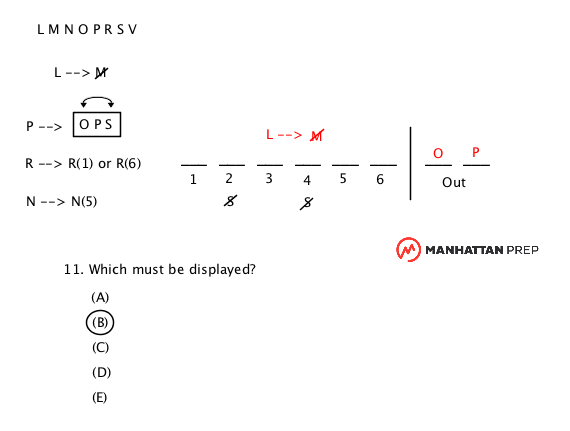
LSAT Forum
5 postsPage 1 of 1
-

- ManhattanPrepLSAT1
-
Thanks Received: 1909
-
Atticus Finch

- Posts: 2851
- Joined: October 07th, 2009
-

- b.lin.22.13
-
Thanks Received: 2
-
Vinny Gambini

- Posts: 14
- Joined: September 15th, 2016
Re: Q11
I'm a little confused by the diagram for this question. I know L or M has to be out, but why does O force P out (as the diagram suggests)?
-

- nima.sahebi
-
Thanks Received: 1
-
Vinny Gambini

- Posts: 2
- Joined: September 13th, 2015
Re: Q11
what he's trying to show is that either L or M have to be out, meaning there's only one spot left in the "out" group. with that in mind S or o can't fill that spot otherwise P's condition wouldn't be met. so S and O are always in. S isn't on the list so the answers O
-

- christine.defenbaugh
-
Thanks Received: 585
-
Atticus Finch

- Posts: 536
- Joined: May 17th, 2013
- This post thanked 1 time.
Re: Q11
Let me see if I can clarify a bit.
Basically, the above diagram is what one might come up with if we were plugging and chugging the answer choices. To determine which bowl had to be in, we'd just try to put each one out, and see if we could get away with it.
If we're testing answer choice (B), we'd start by sticking O out. Once O is out, P must also be out. (To see why, imagine what would happen if P were to be IN....it would have to be next to O! And if O is out, that can't ever happen, so....P isn't going to be allowed in.) At this point, both the two out group spots are filled, meaning everyone else will have to be in.
And that's a big problem, because L and M hate each other, and if one of them is in, the other must go out.
So, JulianG99 - you're totally correct that three things would have to be out in scenario! That's the whole point! If three things are out, this scenario is impossible. If it's impossible to throw O out, then I guess he's gotta be in!
Now, it's possible to make this inference (as well as the inference that S must be in), up front, as Nima.sahebi points out - particularly if you've added the L/M placeholder to one of the two out-group spots right from the get-go. At that point we can consider the contrapositive of the P rule.
Original rule: If P is in, then OPS or SPO
Contrapositive: If the OPS or SPO chunk won't work, then P will have to be out.
Implication: If either O or S is out, the chunk dies, and P has to come out too. Since there isn't room left in the out group for that to happen, we can never allow it to be triggered. O and S will always have to be in!
Basically, the above diagram is what one might come up with if we were plugging and chugging the answer choices. To determine which bowl had to be in, we'd just try to put each one out, and see if we could get away with it.
If we're testing answer choice (B), we'd start by sticking O out. Once O is out, P must also be out. (To see why, imagine what would happen if P were to be IN....it would have to be next to O! And if O is out, that can't ever happen, so....P isn't going to be allowed in.) At this point, both the two out group spots are filled, meaning everyone else will have to be in.
And that's a big problem, because L and M hate each other, and if one of them is in, the other must go out.
So, JulianG99 - you're totally correct that three things would have to be out in scenario! That's the whole point! If three things are out, this scenario is impossible. If it's impossible to throw O out, then I guess he's gotta be in!
Now, it's possible to make this inference (as well as the inference that S must be in), up front, as Nima.sahebi points out - particularly if you've added the L/M placeholder to one of the two out-group spots right from the get-go. At that point we can consider the contrapositive of the P rule.
Original rule: If P is in, then OPS or SPO
Contrapositive: If the OPS or SPO chunk won't work, then P will have to be out.
Implication: If either O or S is out, the chunk dies, and P has to come out too. Since there isn't room left in the out group for that to happen, we can never allow it to be triggered. O and S will always have to be in!
5 posts Page 1 of 1